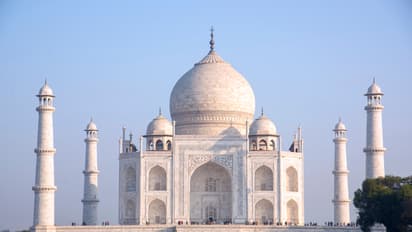Explained | Rain, stone cracks & rust: ASI experts on why Taj Mahal's iconic dome suffered leakage

Synopsis
In a dramatic development that has reverberated across India and the globe, the majestic Taj Mahal is once again in the spotlight due to troubling reports of water seepage and dampness within its hallowed tombs.
In a dramatic development that has reverberated across India and the globe, the majestic Taj Mahal is once again in the spotlight due to troubling reports of water seepage and dampness within its hallowed tombs. The venerable structure, an emblem of eternal love and one of the Seven Wonders of the World, finds itself grappling with a moisture crisis, a situation uncovered following an extended deluge in Agra. This revelation, first brought to light by the Times of India (TOI) on Friday, has elicited profound concern from enthusiasts and conservationists alike.
The Archaeological Survey of India (ASI), in response to the alarming situation, embarked on a meticulous inspection of the mausoleum's roof and dome. Utilizing advanced drone technology, a senior ASI official disclosed on Saturday, "Survey of the main dome was conducted using a drone. Rust was observed on the base of the finial. This rust formation could have led to the development of cracks in the stone, causing water seepage. Repair work of this crack will now be undertaken to prevent future water leakage. Moisture was observed inside the main tombs, indicating the possibility of a fine crack on the stones of the dome."
Also read: 8 unknown facts of Taj Mahal you should know
In a subsequent statement, Superintending Archaeologist Rajkumar Patel elaborated, "Metal swelling due to rusting developed the possibility of a hairline crack. An investigation is in progress. As the surface of the dome gets dry, the process of grouting and packing will be initiated. It will take some time for dampness to subside from the walls of the main mausoleum."
NO FIRST TIME
Interestingly, the Taj Mahal's struggle with seepage is not unprecedented. Recently, several videos of the Taj Mahal's main dome witnessing water seepage due to incessant rains went viral online.
Historical records reveal that the monument experienced its first known seepage as far back as 1652, when Prince Aurangzeb lamented over water dripping from two points on the northern side of the dome. Subsequent repairs were undertaken during the British era in 1872 under the aegis of engineer JW Alexander.
The monument’s finial, originally a 30-foot-high golden spire weighing approximately 466 kg, was replaced with a gold-plated copper structure in 1810. It underwent further replacements in 1876 and 1940.
The challenges faced by the Taj Mahal are mirrored by similar issues at the Agra Fort. On Friday, ASI’s senior conservation assistant Kalandar Bind conducted a thorough assessment of the fort's various structures, including the Musamman Burj, Diwan-e-Aam, Moti Masjid, and Khas Mahal.
The inspection revealed troubling seepage in Khas Mahal, highlighting an urgent need for conservation efforts to safeguard the fort's architectural splendor.
Stay updated with the Breaking News Today and Latest News from across India and around the world. Get real-time updates, in-depth analysis, and comprehensive coverage of India News, World News, Indian Defence News, Kerala News, and Karnataka News. From politics to current affairs, follow every major story as it unfolds. Get real-time updates from IMD on major cities weather forecasts, including Rain alerts, Cyclone warnings, and temperature trends. Download the Asianet News Official App from the Android Play Store and iPhone App Store for accurate and timely news updates anytime, anywhere.